Comparison of Different Cervical Finish Lines of All-Ceramic Crowns on Primary Molars in Finite Element Analysis
Abstract
:1. Introduction
2. Materials and Methods
2.1. Model Preparation
2.2. Finite Element Method (FEM)
2.3. Statistical Analysis
3. Results
4. Discussion
5. Conclusions
Author Contributions
Funding
Acknowledgments
Conflicts of Interest
References
- Sheiham, A. Dental caries affects body weight, growth and quality of life in pre-school children. Br. Dent. J. 2016, 201, 625–626. [Google Scholar] [CrossRef] [Green Version]
- Anderson, M. Risk assessment and epidemiology of dental caries: Review of the literature. Pediatr. Dent. 2002, 24, 377–385. [Google Scholar] [PubMed]
- American Academy on Pediatric Dentistry Council on Clinical Affairs. Policy on use of a caries-risk assessment tool (CAT) for infants, children, and adolescents. Pediatr. Dent. 2007, 29, 29–33. [Google Scholar]
- Seale, N.S.; Randall, R. The use of stainless steel crowns: A systematic literature review. Pediatr. Dent. 2015, 37, 145–160. [Google Scholar] [PubMed]
- Planells del Pozo, P.; Fuks, A. Zirconia crowns-an esthetic and resistant restorative alternative for ECC affected primary teeth. J. Clin. Pediatr. Dent. 2014, 38, 193–195. [Google Scholar] [CrossRef]
- El Shahawy, O.I.; O’Connell, A.C. Successful restoration of severely mutilated primary incisors using a novel method to retain zirconia crowns—Two year results. J. Clin. Pediatr. Dent. 2016, 40, 425–430. [Google Scholar] [CrossRef]
- Randall, R.C. Preformed metal crowns for primary and permanent molar teeth: Review of the literature. Pediatr. Dent. 2002, 24, 489–500. [Google Scholar]
- Innes, N.P.; Ricketts, D.N.; Evans, D.J. Preformed metal crowns for decayed primary molar teeth. Cochrane Database Syst. Rev. 2007, 24, 005512. [Google Scholar] [CrossRef] [Green Version]
- Santamaría, R.M.; Pawlowitz, L.; Schmoeckel, J.; Alkilzy, M.; Splieth, C.H. Use of stainless steel crowns to restore primary molars in Germany: Questionnaire-based cross-sectional analysis. Int. J. Pediatr. Dent. 2018, 28, 587–594. [Google Scholar] [CrossRef]
- Roberts, C.; Lee, J.Y.; Wright, J.T. Clinical evaluation of and parental satisfaction with resin-faced stainless steel crowns. Pediatr. Dent. 2001, 23, 28–31. [Google Scholar]
- Shah, P.V.; Lee, J.Y.; Wright, J.T. Clinical success and parental satisfaction with anterior preveneered primary stainless steel crowns. Pediatr. Dent. 2004, 26, 391–395. [Google Scholar] [PubMed]
- Salami, A.; Walia, T.; Bashiri, R. Comparison of parental satisfaction with three tooth-colored full-coronal restorations in primary maxillary incisors. J. Clin. Pediatr. Dent. 2015, 39, 423–428. [Google Scholar] [CrossRef] [PubMed]
- Champagne, C.; Waggoner, W.; Ditmyer, M.; Casamassimo, P.S. Parental satisfaction with preveneered stainless steel crowns for primary anterior teeth. Pediatr. Dent. 2007, 29, 465–469. [Google Scholar] [PubMed]
- Waggoner, W.F. Restoring primary anterior teeth: Updated for 2014. Pediatr. Dent. 2015, 37, 163–170. [Google Scholar] [PubMed]
- Clark, L.; Wells, M.H.; Harris, E.F.; Lou, J. Comparison of amount of primary tooth reduction required for anterior and posterior zirconia and stainless steel crowns. Pediatr. Dent. 2016, 38, 42–46. [Google Scholar]
- Holsinger, D.M.; Wells, M.H.; Scarbecz, M.; Donaldson, M. Clinical evaluation and parental satisfaction with pediatric zirconia anterior crowns. Pediatr. Dent. 2016, 38, 192–197. [Google Scholar]
- Choi, J.-W.; Bae, I.-H.; Noh, T.-H.; Ju, S.-W.; Lee, T.-K.; Ahn, J.-S.; Jeong, T.-S.; Huh, J.-B. Wear of primary teeth caused by opposed all-ceramic or stainless steel crowns. J. Adv. Prosthodont. 2016, 8, 43–52. [Google Scholar] [CrossRef] [Green Version]
- Aiem, E.; Smaïl-Faugeron, V.; Muller-Bolla, M. Aesthetic preformed paediatric crowns: Systematic review. Int. J. Paediatr. Dent. 2017, 27, 273–282. [Google Scholar] [CrossRef]
- Pieger, S.; Salman, A.; Bidra, A.S. Clinical outcomes of lithium disilicate single crowns and partial fixed dental prostheses: A systematic review. J. Prosthet. Dent. 2014, 112, 22–30. [Google Scholar] [CrossRef]
- Albakry, M.; Guazzato, M.; Swain, M.V. Biaxial flexural strength, elastic moduli, and x-ray diffraction characterization of three pressable all-ceramic materials. J. Prosthet. Dent. 2003, 89, 374–380. [Google Scholar] [CrossRef]
- Jing, L.; Chen, J.W.; Roggenkamp, C.; Suprono, M.S. Effect of preparation height on retention of a prefabricated primary posterior zirconia crown. Pediatr. Dent. 2019, 41, 229–233. [Google Scholar] [PubMed]
- Denry, I.; Kelly, J.R. State of the art of zirconia for dental applications. Dent Mater 2008, 24, 299–307. [Google Scholar] [CrossRef] [PubMed]
- Alghazzawi, T.F.; Lemons, J.; Liu, P.R.; Essig, M.E.; Janowski, G.M. The failure load of CAD/CAM generated zirconia and glass-ceramic laminate veneers with different preparation designs. J. Prosthet. Dent. 2012, 108, 386–393. [Google Scholar] [CrossRef]
- Lan, T.H.; Liu, P.H.; Chou, M.M.; Lee, H.E. Fracture resistance of monolithic zirconia crowns with different occlusal thicknesses in implant prostheses. J. Prosthet. Dent. 2016, 115, 76–83. [Google Scholar] [CrossRef] [PubMed]
- Sasse, M.; Krummel, A.; Klosa, K.; Kern, M. Influence of restoration thickness and dental bonding surface on the fracture resistance of full-coverage occlusal veneers made from lithium disilicate ceramic. Dent. Mater. 2015, 31, 907–915. [Google Scholar] [CrossRef] [PubMed]
- Gupta, S.; Gupta, G.; Sharma, M.; Sharma, P.; Goyal, S.; Kumar, P. An evaluation of the stress pattern distribution for orthodontic tooth movements—A finite element study. Int. Dent. J. 2015, 3, 91–96. [Google Scholar] [CrossRef] [Green Version]
- Comlekoglu, M.; Dundar, M.; Özcan, M.; Gungor, M.; Gokce, B.; Artunc, C. Influence of cervical finish line type on the marginal adaptation of zirconia ceramic crowns. Oper. Dent. 2009, 34, 586–592. [Google Scholar] [CrossRef] [Green Version]
- Bindl, A.; Mörmann, W. Marginal and internal fit of all-ceramic CAD/CAM crown-copings on chamfer preparations. J. Oral Rehabil. 2005, 32, 441–447. [Google Scholar] [CrossRef]
- Lan, T.H.; Pan, C.Y.; Liu, P.H.; Chou, M.M.C. Fracture resistance of monolithic zirconia crowns on four occlusal convergent abutments in implant prosthesis. Appl. Sci. 2019, 9, 2585. [Google Scholar] [CrossRef] [Green Version]
- Azcarate-Velázquez, F.; Castillo-Oyagüe, R.; Oliveros-López, L.G.; Torres-Lagares, D.; Martínez-González, Á.J.; Pérez-Velasco, A.; Lynch, C.D.; Gutiérrez-Pérez, J.L.; Serrera-Figallo, M.Á. Influence of bone quality on the mechanical interaction between implant and bone: A finite element analysis. J. Dent. 2019, 103161. [Google Scholar] [CrossRef]
- Shetty, P.P.; Meshramkar, R.; Patil, K.N.; Nadiger, R.K. A finite element analysis for a comparative evaluation of stress with two commonly used esthetic posts. Euro. J. Dent. 2013, 7, 419–422. [Google Scholar] [CrossRef] [PubMed] [Green Version]
- Archangelo, C.M.; Rocha, E.P.; Anchieta, R.B.; Martin, M.; Freitas, A.C.; Ko, C.-C.; Cattaneo, P.M. Influence of buccal cusp reduction when using porcelain laminate veneers in premolars. A comparative study using 3-D finite element analysis. J. Prosthodont. Res. 2011, 55, 221–227. [Google Scholar] [CrossRef] [PubMed] [Green Version]
- Jovanovic, N.; Petrovic, B.; Kojic, S.; Sipovac, M.; Markovic, D.; Stefanovic, S.; Stojanovic, G. Primary teeth bite marks analysis on various materials: A possible tool in children health risk analysis and safety assessment. Int. J. Env. Res Public Health 2019, 16, 2434. [Google Scholar] [CrossRef] [PubMed] [Green Version]
- Bramanti, E.; Cervino, G.; Lauritano, F.; Fiorillo, L.; D’Amico, C.; Sambataro, S.; Denaro, D.; Famà, F.; Ierardo, G.; Polimeni, A.; et al. FEM and von mises analysis on prosthetic crowns structural elements: Evaluation of different applied materials. Sci. World J. 2017, 2017, 1029574. [Google Scholar] [CrossRef] [PubMed] [Green Version]
- Dar, F.H.; Meakin, J.R.; Aspden, R.M. Statistical methods in finite element analysis. J. Biomech. 2002, 35, 1155–1161. [Google Scholar] [CrossRef]
- Lin, C.L.; Wang, J.C.; Chang, W.J. Biomechanical interactions in tooth–implant-supported fixed partial dentures with variations in the number of splinted teeth and connector type: A finite element analysis. Clin. Oral Implant. Res. 2008, 19, 107–117. [Google Scholar] [CrossRef]
- Lan, T.H.; Du, J.K.; Pan, C.Y.; Lee, H.E.; Chung, W.H. Biomechanical analysis of alveolar bone stress around implants with different thread designs and pitches in the mandibular molar area. Clin. Oral Investig. 2012, 363–369. [Google Scholar] [CrossRef]
- Ashima, G.; Sarabjot, K.B.; Gauba, K.; Mittal, H.C. Zirconia crowns for rehabilitation of decayed primary incisors: An esthetic alternative. J. Clin. Pediatr. Dent. 2014, 39, 18–22. [Google Scholar] [CrossRef]
- Abdulhadi, B.S.; Abdullah, M.M.; Alaki, S.M.; Alamoudi, N.M.; Attar, M.H. Clinical evaluation between zirconia crowns and stainless steel crowns in primary molars teeth. J. Pediatr. Dent. 2017, 5, 21–27. [Google Scholar] [CrossRef]
- Hayashi, R.K.; Chaconas, S.J.; Caputo, A.A. Effects of force direction on supporting bone during tooth movement. J. Am. Dent. Assoc. 1975, 90, 1012–1017. [Google Scholar] [CrossRef]
- Simsek, H.; Derelioglu, S. In vitro comparative analysis of fracture resistance in inlay restoration prepared with CAD-CAM and different systems in the primary teeth. Biomed. Res. Int. 2016, 2016, 4292761. [Google Scholar] [CrossRef] [PubMed]
- Alessandretti, R.; Borba, M.; Benetti, P.; Corazza, P.H.; Ribeiro, R.; Della Bona, A. Reliability and mode of failure of bonded monolithic and multilayer ceramics. Dent. Mater. 2017, 33, 191–197. [Google Scholar] [CrossRef] [PubMed]
- Sfondrini, M.F.; Gandini, P.; Malfatto, M.; Di Corato, F.; Trovati, F.; Scribante, A. Computerized casts for orthodontic purpose using powder-free intraoral scanners: Accuracy, execution time, and patient feedback. Biomed. Res. Int. 2018, 2018, 4103232. [Google Scholar] [CrossRef] [PubMed] [Green Version]
- Jalalian, E.; Aletaha, N.S. The effect of two marginal designs (chamfer and shoulder) on the fracture resistance of all-ceramic restoration, inceram: An in vitro study. J. Prosthodont. Res. 2011, 55, 121–125. [Google Scholar] [CrossRef] [PubMed] [Green Version]
- Lan, T.H.; Pan, C.Y.; Liu, P.H.; Chou, M.M.C. Fracture resistance of monolithic zirconia crowns in implant prostheses in patients with bruxism. Materials 2019, 12, 1623. [Google Scholar] [CrossRef] [PubMed] [Green Version]
- Wegner, S.M.; Kern, M. Long-term resin bond strength to zirconia ceramic. J. Adhes. Dent. 2000, 2, 139–147. [Google Scholar]
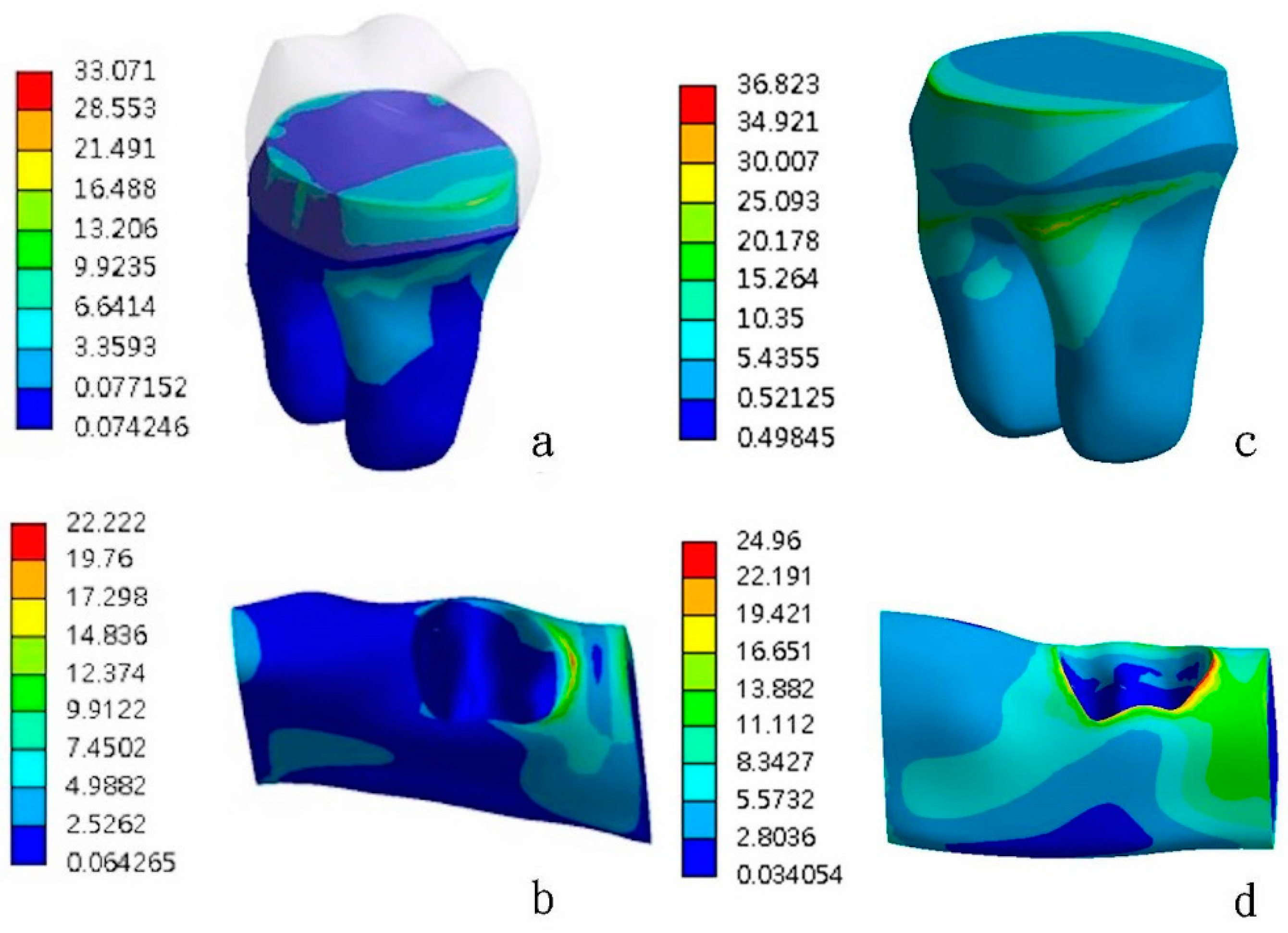
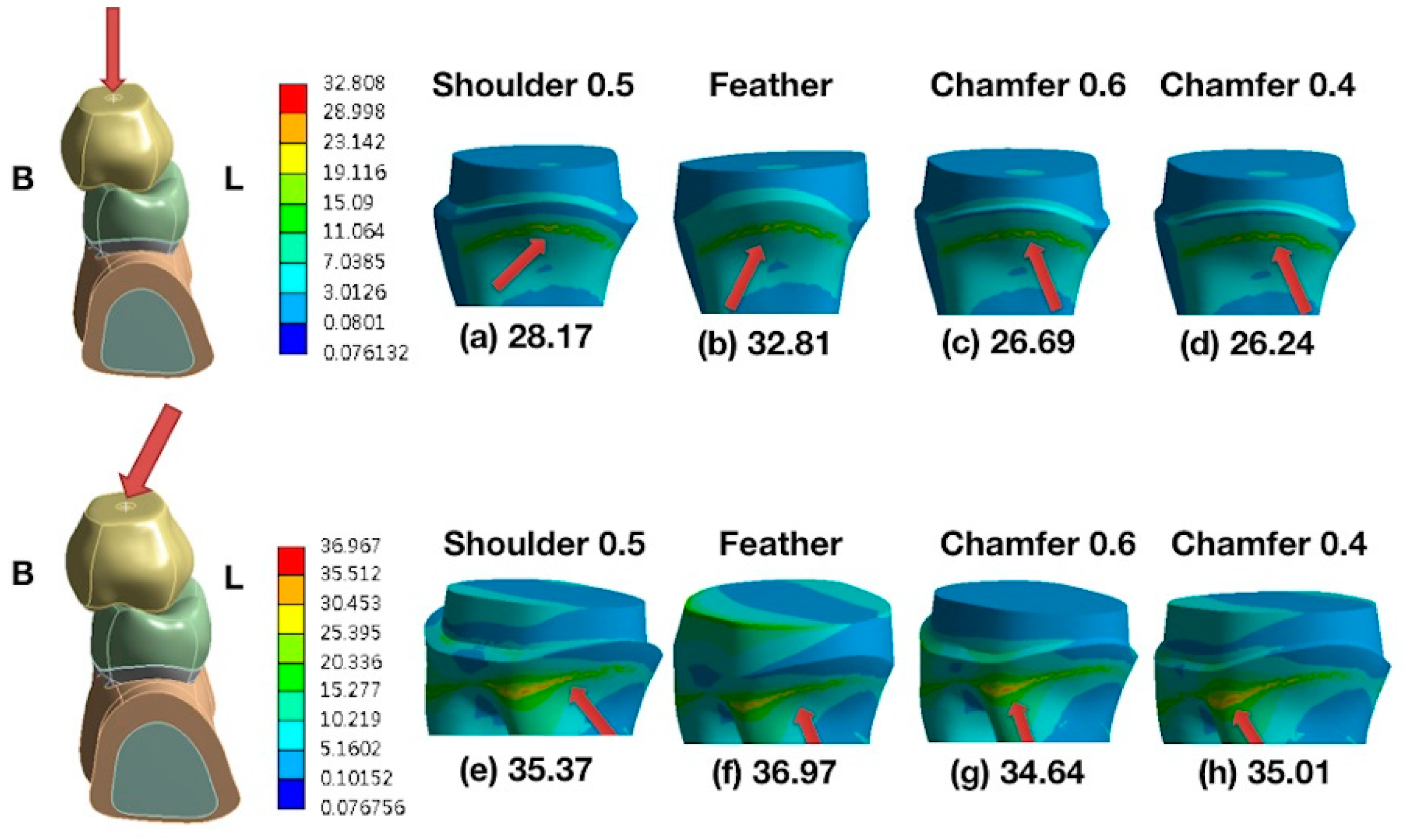
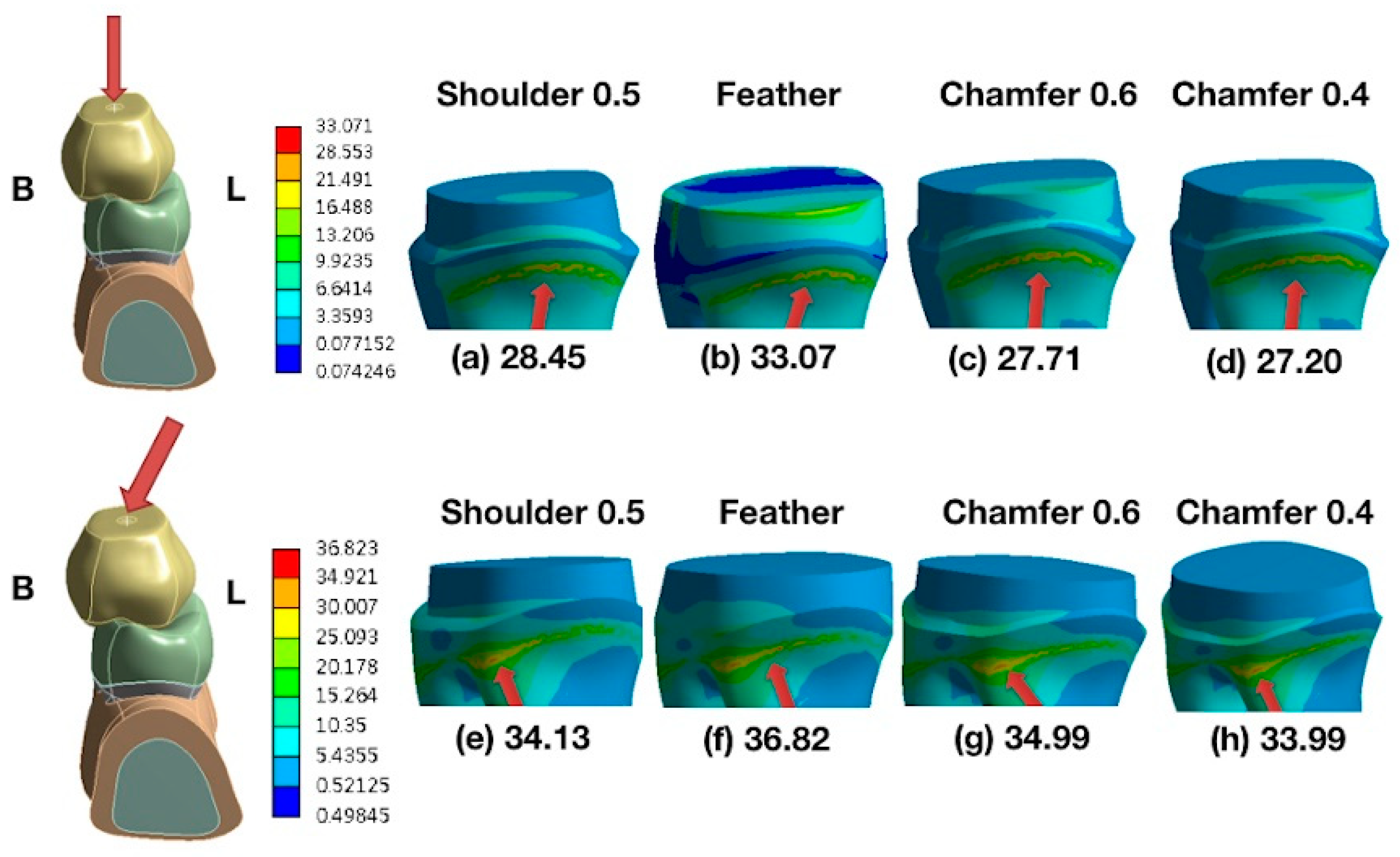
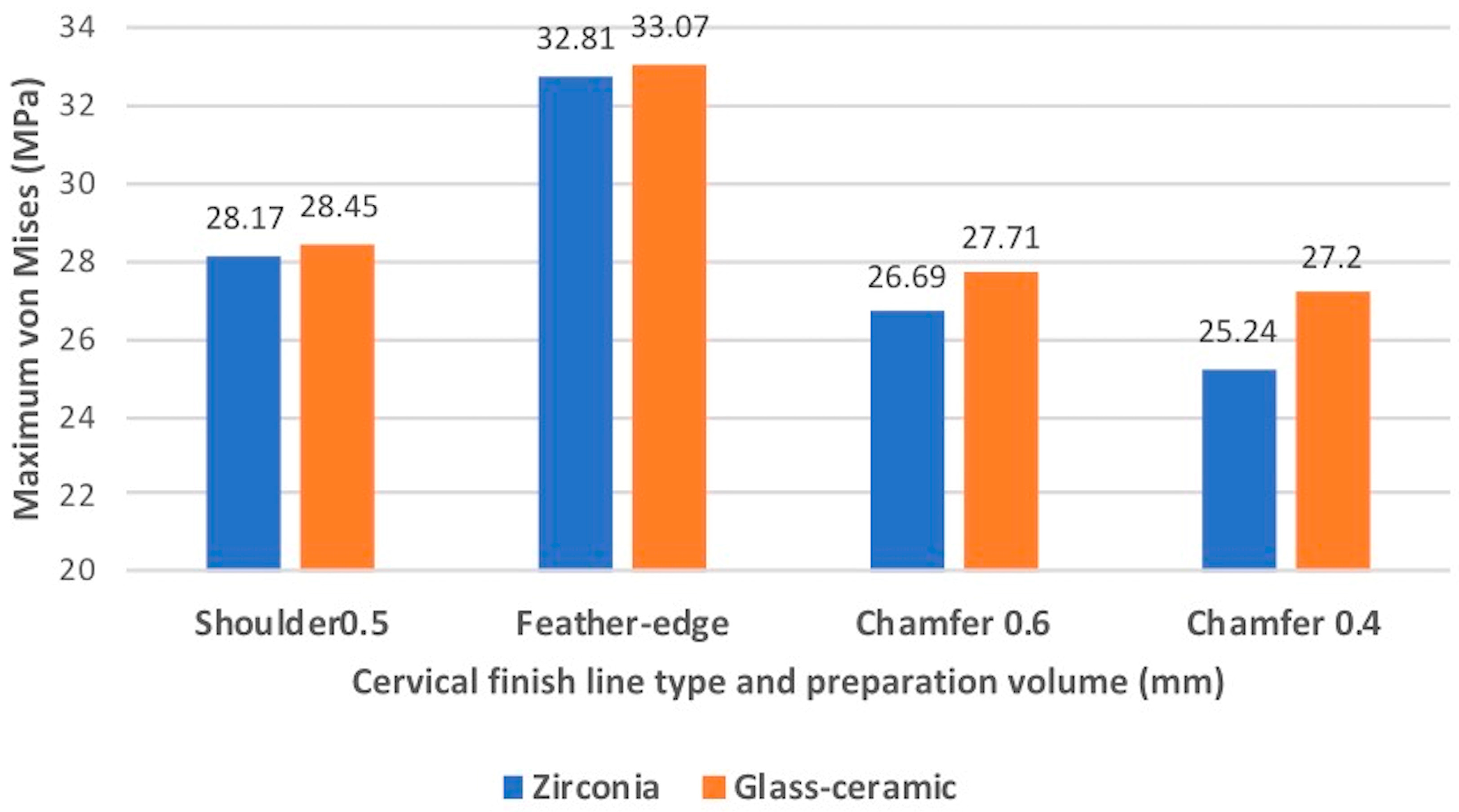
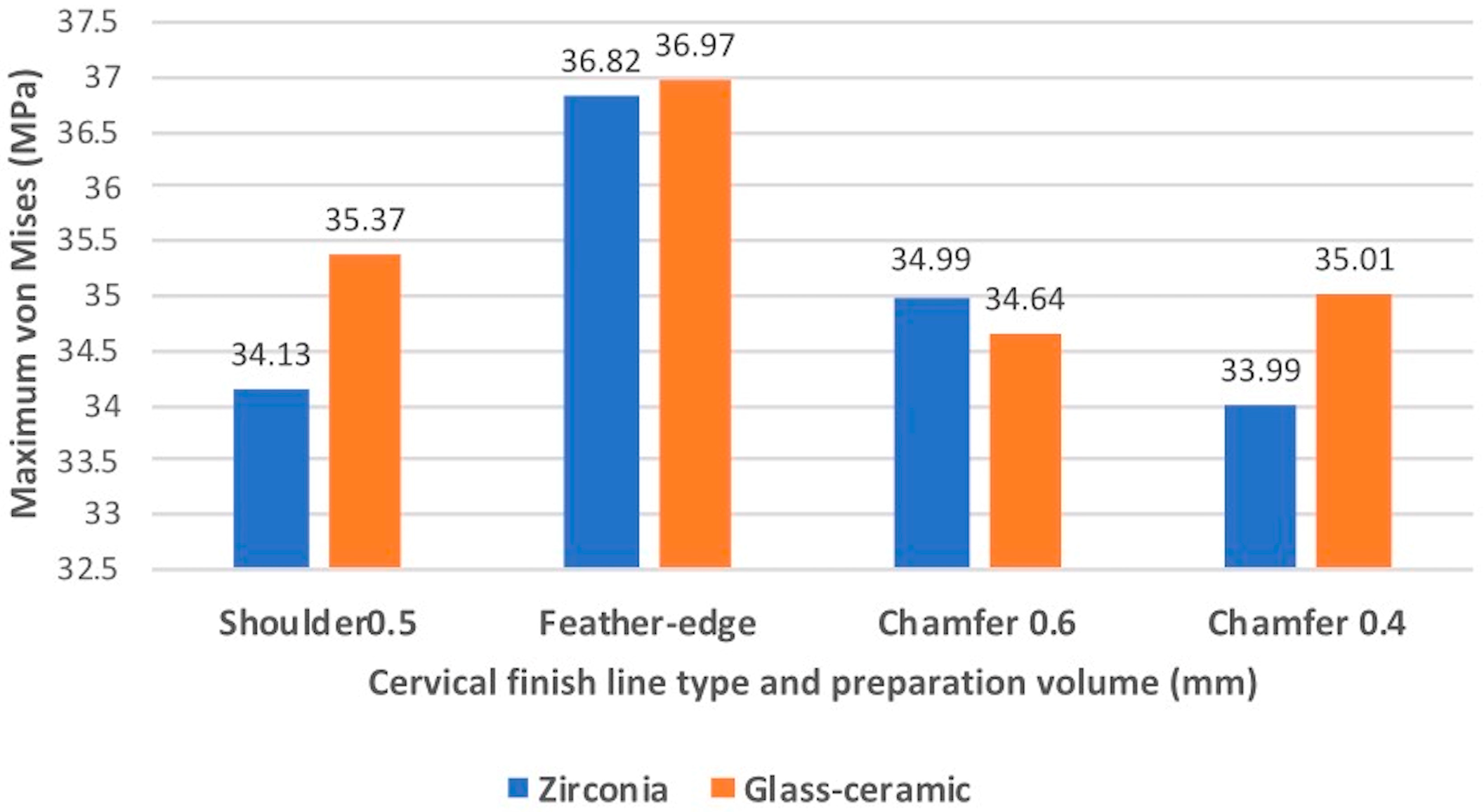
| Material | Young’s Modulus (GPa) | Poisson Ratio (ν) |
|---|---|---|
| ZrO2 [29] | 220 | 0.3 |
| Lithium disilicate [20] | 91 | 0.23 |
| Cortical bone [30] | 13.7 | 0.3 |
| Cancellous bone [30] | 1.85 | 0.3 |
| Dentin [31] | 18.6 | 0.31 |
| Resin cement [32] | 8.3 | 0.3 |
| Source | DF | SS | MS | %TSS | P |
|---|---|---|---|---|---|
| Loading type | 1 | 149.19 | 149.19 | 90.25 | 0.000* |
| Finish line type | 3 | 41.286 | 13.76 | 8.33 | 0.000* |
| Finish line type x Loading type | 3 | 7.01 | 2.34 | 1.42 | 0.002* |
| Total | 165.29 | 100.00 |
| Source | DF | SS | MS | %TSS | P |
|---|---|---|---|---|---|
| Loading type | 1 | 149.19 | 149.19 | 99.6 | 0.000* |
| Ceramic type | 1 | 0.31 | 0.31 | 0.2 | 0.79 |
| Loading type x Ceramic type | 1 | 0.22 | 0.22 | 0.2 | 0.82 |
| Total | 149.72 | 100.00 |
© 2020 by the authors. Licensee MDPI, Basel, Switzerland. This article is an open access article distributed under the terms and conditions of the Creative Commons Attribution (CC BY) license (http://creativecommons.org/licenses/by/4.0/).
Share and Cite
Pan, C.-Y.; Lan, T.-H.; Liu, P.-H.; Fu, W.-R. Comparison of Different Cervical Finish Lines of All-Ceramic Crowns on Primary Molars in Finite Element Analysis. Materials 2020, 13, 1094. https://doi.org/10.3390/ma13051094
Pan C-Y, Lan T-H, Liu P-H, Fu W-R. Comparison of Different Cervical Finish Lines of All-Ceramic Crowns on Primary Molars in Finite Element Analysis. Materials. 2020; 13(5):1094. https://doi.org/10.3390/ma13051094
Chicago/Turabian StylePan, Chin-Yun, Ting-Hsun Lan, Pao-Hsin Liu, and Wan-Ru Fu. 2020. "Comparison of Different Cervical Finish Lines of All-Ceramic Crowns on Primary Molars in Finite Element Analysis" Materials 13, no. 5: 1094. https://doi.org/10.3390/ma13051094





